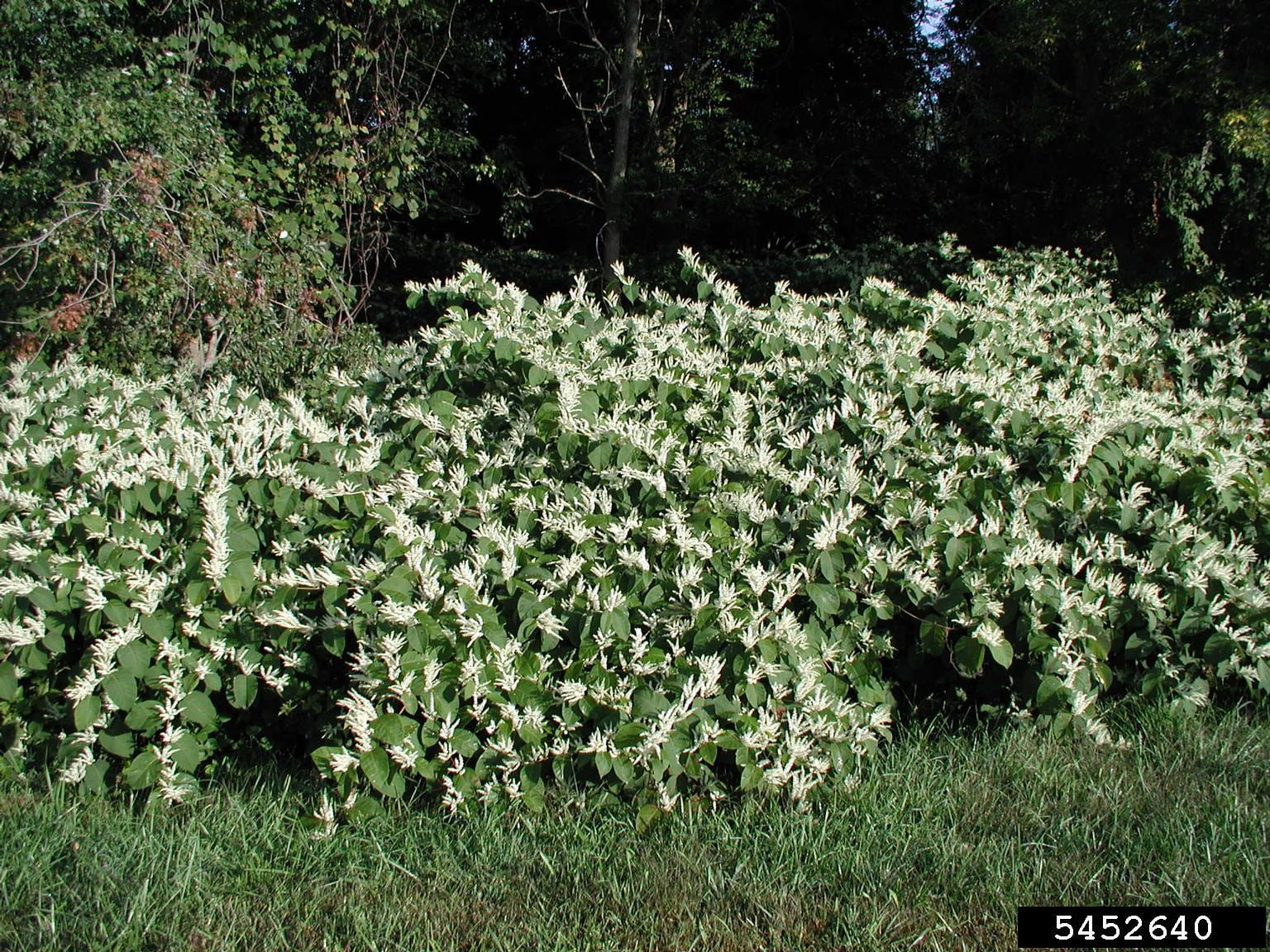Japanese Knotweed (Reynoutria japonica) is an invasive weed that is problematic in perennial agricultural systems such as berry crops and tree fruit. It is also found on landscapes, sodded storm drains, river banks, roadsides, waste areas and untended gardens. This weed tends to thrive on moist, well-drained, nutrient rich soil and is present throughout the Northeast. Japanese knotweed and the related giant, Bohemian, and Himalayan knotweeds are fast-growing and form dense stands, allowing little to no other vegetation to survive. It is semi-shade tolerant, but is most aggressive in full sun.
Identification
Seedlings: Seedlings are rarely encountered. Most new plants arise from stem or root fragments; early growth will be young reddish shoots emerging from the plant fragment.

Japanese Knotweed Seedling
photo by Ohio State Weed Lab via The Ohio State University, Bugwood.org

Japanese knotweed emerging from roots
Photo by Leslie J. Mehrhoff of the University of Connecticut, via Bugwood.org
Mature plant: Knotweed stems are hollow, stout, and green to purple, with prominent joints where leaves emerge from the stem. Leaves alternate, 8-15 cm long and 5-10 cm wide (3-6″ long by 2-4″ wide), and are broadly egg-shaped with a flat base and pointed tip. The root system is extensive, with a large root ball and underground root runners (rhizomes). This plant spreads mainly by these spreading rhizomes and stem fragments; any piece of the plant with a root or stem joint can start a new plant.
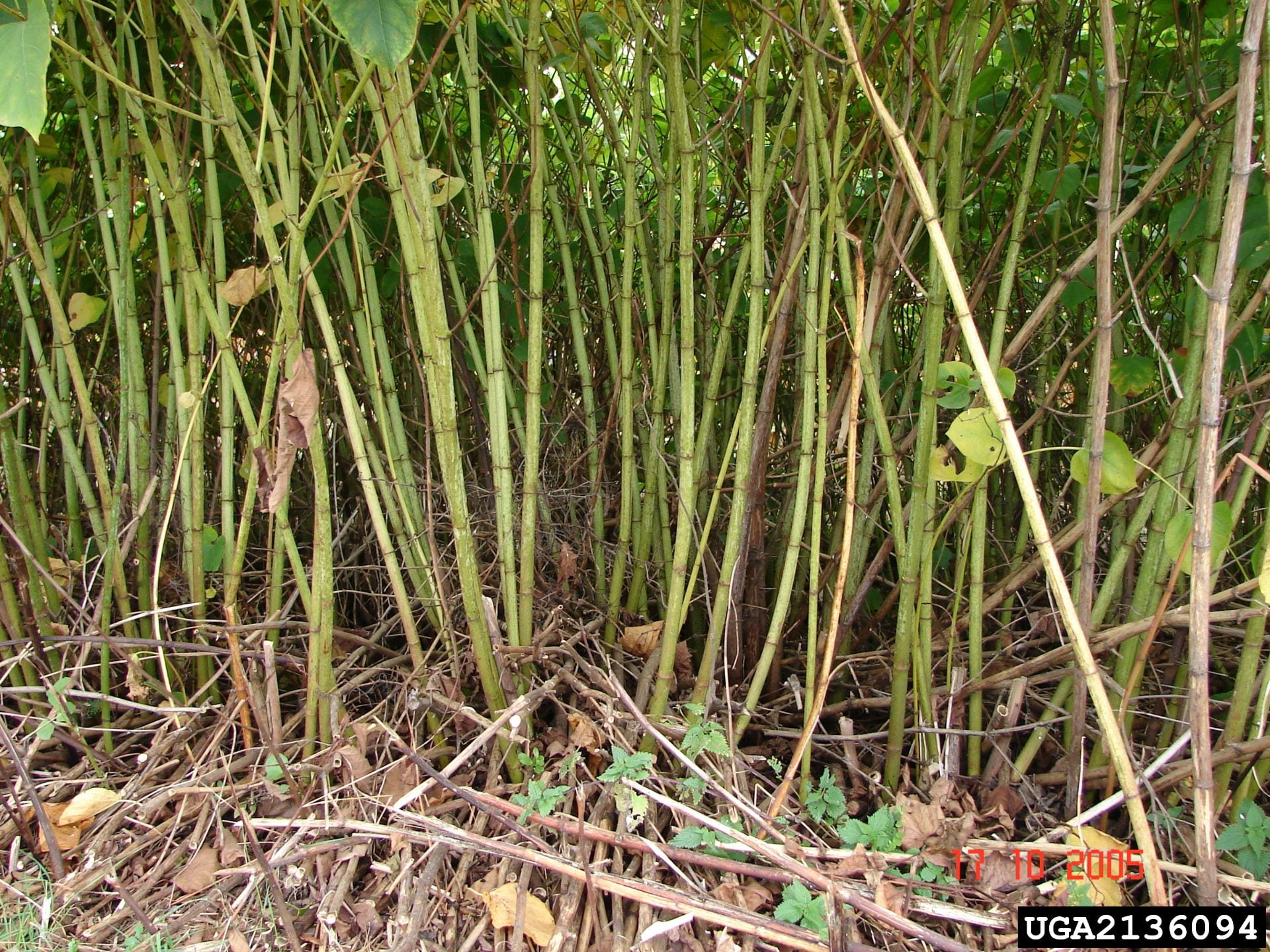
Thicket of Japanese knotweed stems
Photo by Barbara Tokarska-Guzik of the University of Silesia, Poland, via Bugwood.org
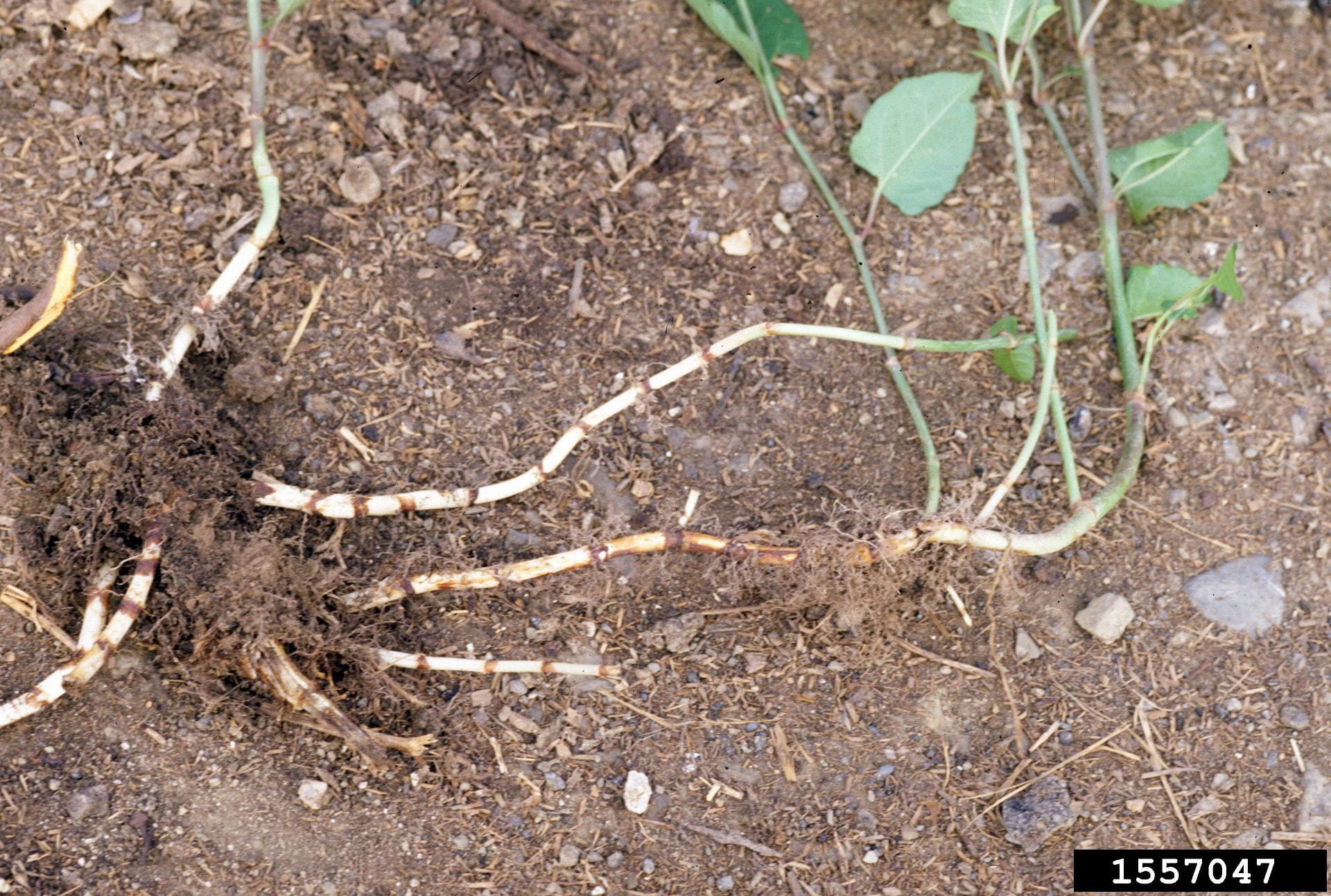
Japanese knotweed root structure
Photo by John Cardina of OSU, via Bugwood.org
Flowers/Fruit: Knotweed produces a showy spray of numerous, small white flowers, which bloom on elongated clusters in late summer. The plant is insect-pollinated and is often frequented by honeybees. Seeds are 3mm (1/10”), dark brown, triangular, and enclosed within a 3-winged papery husk (calyx).

Japanese Knotweed seeds
photo by Ken Chamberlain via The Ohio State University, Bugwood.org
Similar Species: There are several very similar large knotweed species, which are alike in aggressiveness, spread, and management. In New York, these include giant knotweed (Reynoutria sachalinensis) and the hybrid between giant and Japanese knotweed, bohemian knotweed (R. ×bohemica). Here are images of the three species’ flowers and leaves. Practically, all three can be managed similarly.
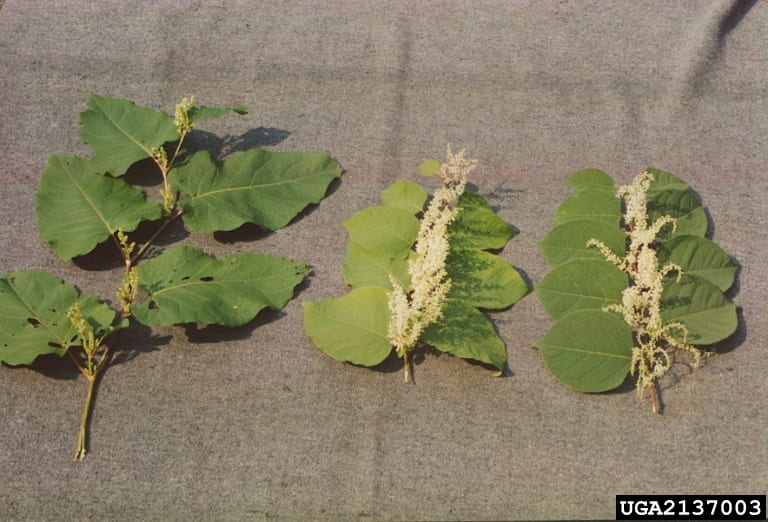
Similar large knotweed species: giant knotweed on the left, bohemian knotweed in the center, and Japanese knotweed on the right.
Photo by Barbara Tokarska-Guzlik of the University of Silesia, Poland, via Bugwood.org.
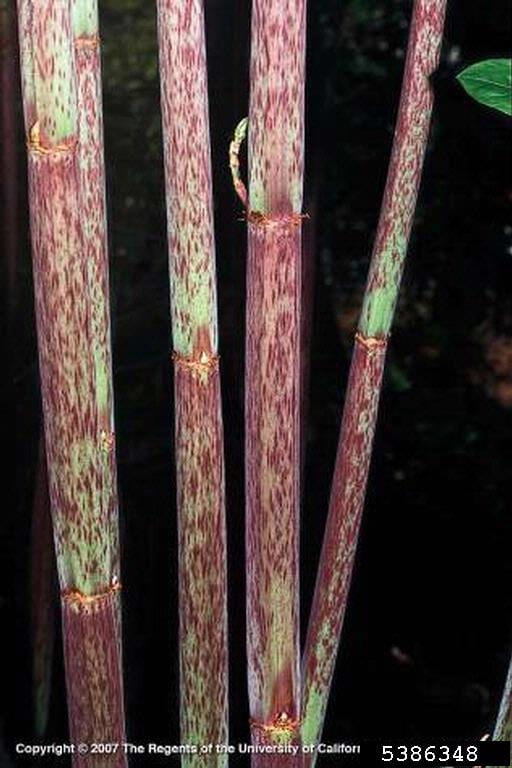
Japanese knotweed stems, showing purple mottling.
Photo by Joseph M. DiTomaso of UC-Davis, via Bugwood.org.
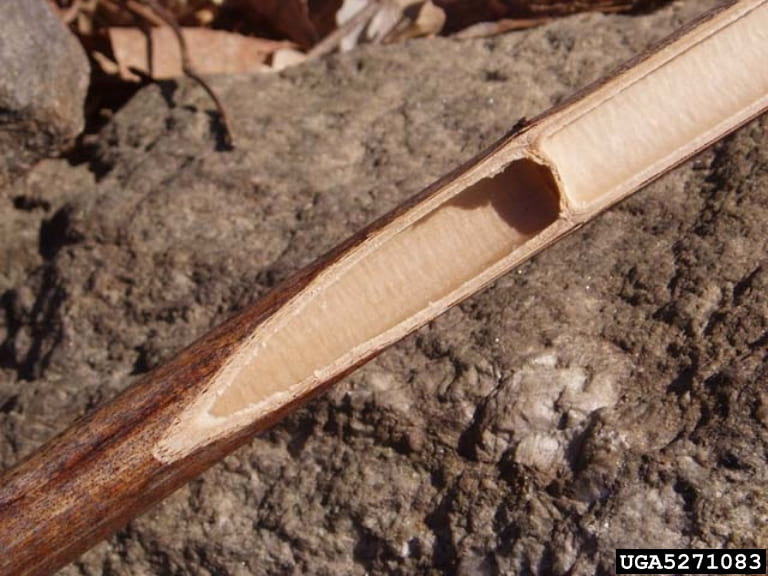
Japanese knotweed stems are hollow and chambered.
Photo by Leslie J. Mehrhoff of the University of Conncicut, via Bugwood.org.
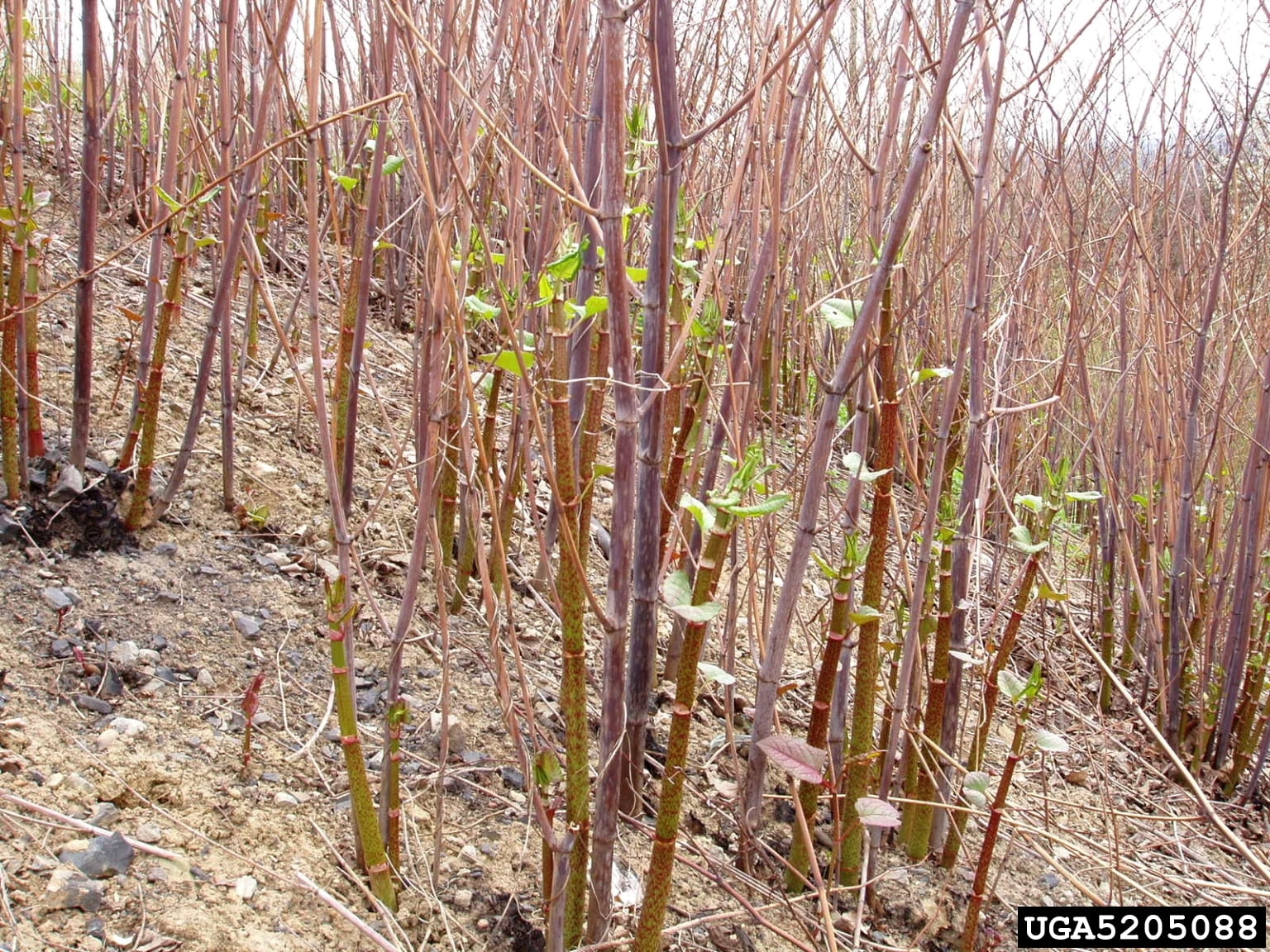
Japanese knotweed stems from previous year, with new spring growth.
Photo by Jan Samanek of the Phytosanitary Administration, via Bugwood.org.
Management
Chemical control
The best management practice for Japanese knotweed is a combination of mechanical and chemical control. Mowing or cutting in June with all downed plant material collected and destroyed, followed by glyphosate or triclopyr applications in late summer provides the best control. This is a multi-year endeavor, with repeat applications for several years. Glyphosate-treated knotweed can have epinastic or stunted regrowth, which makes reapplication the following year ineffictive. In this situation, waiting until the second year after treatment allows the plant to produce enough aboveground material for an effective reapplication.
The University of Michigan has produces an excellent publication that details the biology and management of knotweed.
Cornell University’s Turf and Landscape weed identification app provides New York State specific options for chemical management of Japanese knotweed.
Use this tool to look up the efficacy of herbicides on a particular weed species. For general guidance on weed control, get the latest edition of the Cornell Crop and Pest Management Guidelines.
Non-chemical control
For Japanese knotweed, the size of infestation is even more important than normal for selecting a control method. Very small infestations of a few stems can be controlled by carefully digging out the plant and all of the root system, but the site must be monitored for several years and any remaining regrowth dug out as well. Generally a site can be considered managed after no knotweed regrowth is observed for three years. All plant fragments must be removed and destroyed to prevent them from starting new infestations.
Larger infestations are much more difficult to manage without a chemicals. Knotweed’s underground root system is extensive and stores enough energy to regrow for several years. It is worth considering the combination of mechanical and chemical management described to the right, as management without chemicals is difficult and requires many years of continuous effort.
If non-chemical management is the only option, smothering may be the best approach. Cut all knotweed stems in early June, cover them with mulch such as grass clippings, and cover the entire area and a wide buffer around it with a thick, opaque plastic tarp. The buffer is necessary to prevent new growth from the plant’s extensive rhizome (underground runner) system. This tarp is left in place for five years, and must be patched or replaced to maintain continuous cover of the entire plant system.
There is one biocontrol insect for Japanese knotweed under study in New York; research release trials started in 2020 under the direction of the Blossey Lab at Cornell University. This insect is not available to the public yet, and there are no other biocontrols available for knotweed.
See A Grower’s Guide to Organic Apples from Cornell for non-chemical weed control options in apple orchards.
References
Uva R H, Neal J C, DiTomaso J M. 1997. Weeds of the Northeast. Book published by Cornell University, Ithaca NY. The go-to for weed ID in the Northeast; look for a new edition sometime in 2019.
Cornell University’s Turfgrass and Landscape Weed ID app. Identification and control options for weeds common to turf, agriculture, and gardens in New York; uses a very simple decision tree to identify your weed.
Michigan Department of Natural Resources, Michigan Natural Features Inventory, 2012. Invasive Species—Best Control Practices: Japanese Knotweed. This is an excellent treatment of Japanese knotweed identification, biology, and management.
Northwoods Cooperative Weed Management Area: Homeowner’s Guide to Japanese Knotweed Control. 2007.
Profile on Japanese Knotweed by Michigan Department of Natural Resources including extensive descriptions on management.
Profile on Japanese Knotweed from the Weed Report from the Weed Control in Naturala Areas in the Western United States, shared by University of California, Davis.
All images are included from Invasive.org. Offers an extensive online library of images for invasive and exotic species of North America.
Peck, G M and I A Merwin. A Grower’s Guide to Organic Apples. Covers organic weed control methods for organic apple orchards.
Breth, D I and E Tee. 2016. Herbicide AI by Weed Species. This tool allows you to look up the efficacy of an herbicide active ingredient on a particular weed species.

